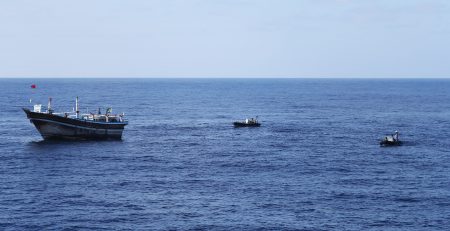Doctrine of Hot Pursuit 24/05/2019 – Posted in: Daily News – Tags: drugs, hot pursuit, International seas
DOCTRINE OF HOT PURSUIT
For: Preliminary & Mains
Topic covers: About the doctrine
News Flash
The Indian Coast Guard (ICG) apprehended a Pakistani fishing vessel off Gujarat and seized 200 kg heroin, worth ₹600 crore in the international market.
During the hot pursuit, the crew threw bags containing suspicious material into the sea.
Doctrine of Hot Pursuit
The doctrine of hot pursuit owes its origin to the law of the seas, and emerged as an exception to the fundamental principle of freedom of the high seas — the rights of vessels of all nations to navigate freely on the high seas.
Article 23 of the Geneva Convention on the High Seas, 1958 codified the concept of hot pursuit. This customary doctrine was again codified in the 1982 United Nations Convention on the Law of High Seas.
Apart from imposing procedural restrictions, the Convention clearly spelt out that the right of hot pursuit ceases as soon as the ship pursued enters the territorial sea of its own country or a third state.
About the Law
The doctrine of hot pursuit in international law recognizes the right of a State to pursue a vessel belonging to a foreign State which has violated any law within its territorial boundaries and jurisdiction.
The doctrine vests a right to pursue the delinquent vessel outside the territorial limits into the open sea and then can be taken into custody.
The fundamental rule of the maritime law states that all vessels have the right to navigate freely on the high seas. Yet, the traditional notion has recognized the doctrine of hot pursuit as an exception to the principles of freedom on the high seas.
Requisites of Hot Pursuit
Article 111 of the UNCLOS also lays down certain conditions which need to be fulfilled to exercise the right validly.
- The State which is exercising its right under the doctrine must have sufficient and valid reason to believe that the foreign vessel has transgressed the law of the State.
- The pursuit must be started when the foreign vessel is within the internal waters, territorial sea, archipelagic waters, contiguous zone or Exclusive Economic Zone of the State.
- The pursuit can be commenced only after the foreign vessel has been given an auditory or visual signal to stop, which has been heard or seen by the foreign vessel.
- The right can be exercised only by authorized government vessels or warships which are identifiable and clearly marked.
- There should be no interruption in the pursuit
- The right comes to an end when the offending vessel enters the territorial sea of its own jurisdiction or any third State.
Conclusion
The doctrine of hot pursuit is of vital importance to the international law and is a firmly anchored concept. But since many factors are included in the exercise of this right and the doctrine is an exception to the fundamental rule of free navigation in the high seas, it should be exercised with utmost caution. The doctrine allows coastal states to protect their own sovereignty by preventing or stopping an alien or foreign vessel from committing an offence in the coastal state’s territory.
Source: The Hindu / NILS India
You can follow us on LinkedIn and for more updates related to UPSC IAS Preparation, Like our Facebook Page and subscribe our Diligent IAS Youtube Channel
Also Read Related Daily News

